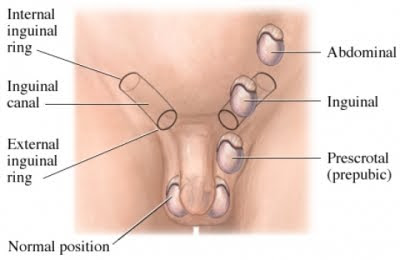
What is an undescended testicle?
The testicle (testis) is responsible for the production of male hormone and also sperm. Before the child is born the testicle migrates down from high in the abdomen and passes through abdominal wall and groin to take its normal position in the scrotum. Undescended testicles are quite common. They may be present in 4% of boys at birth, and there is an even higher incidence in premature infants. Three-fourths of undescended testicles will descend within the first three months of life.
When a testicle is not in the normal scrotal location several possibilities exist:
There may never have been a testicle (congenital absence).
The testicle may have atrophied (withered away) before birth due to torsion (twist) or blockage of the testicular blood vessels.
The testicle may have descended incompletely and may lie within the inguinal canal (just above the scrotum).
The testicle may have not descended properly, but remains within the abdominal cavity.
In some children the testes may be found in the groin, but can be brought down into the scrotum during examination. These 'retractile' testicles also will be seen to descend when the child is in the bathtub. Retractile testicles are due to hyperactive muscles that temporarily pull the testicle into the groin. However, retractile testicles are not believed to injure the testicles and require no treatment.
Why should an undescended testicle be treated?
In humans, the scrotal location of the testicles keeps them cooler than the core body temperature. This lower temperature is important for the development of the testicle as well as for production of normal sperm. Studies have shown that there is an increased risk of infertility in men with a history of undescended testicles. Relocating the testicle into the scrotum may decrease the risk of fertility problems, particularly if done at an early age.

No comments:
Post a Comment